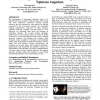Free Online Productivity Tools
i2Speak
i2Symbol
i2OCR
iTex2Img
iWeb2Print
iWeb2Shot
i2Type
iPdf2Split
iPdf2Merge
i2Bopomofo
i2Arabic
i2Style
i2Image
i2PDF
iLatex2Rtf
Sci2ools
DOCENG
2009
ACM
2009
ACM
Deriving image-text document surrogates to optimize cognition
The representation of information collections needs to be optimized for human cognition. While documents often include rich visual components, collections, including personal collections and those generated by search engines, are typically represented by lists of text-only surrogates. By concurrently invoking complementary components of human cognition, combined image-text surrogates will help people to more effectively see, understand, think about, and remember an information collection. This research develops algorithmic methods that use the structural context of images in HTML documents to associate meaningful text and thus derive combined image-text surrogates. Our algorithm first recognizes which documents consist essentially of informative and multimedia content. Then, the algorithm recognizes the informative sub-trees within each such document, discards advertisements and navigation, and extracts images with contextual descriptions. Experimental results demonstrate the algorith...
| Added | 28 May 2010 |
| Updated | 28 May 2010 |
| Type | Conference |
| Year | 2009 |
| Where | DOCENG |
| Authors | Eunyee Koh, Andruid Kerne |
Comments (0)

